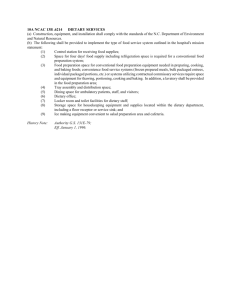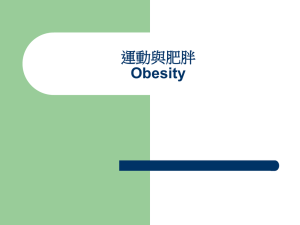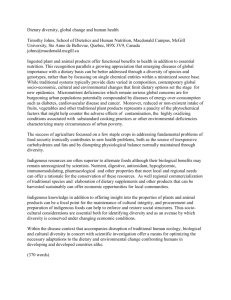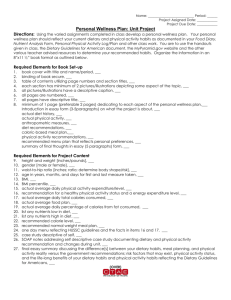O Evolutionary Perspectives on Human Diet and Nutrition DIET AND NUTRITION IN EARLY
advertisement
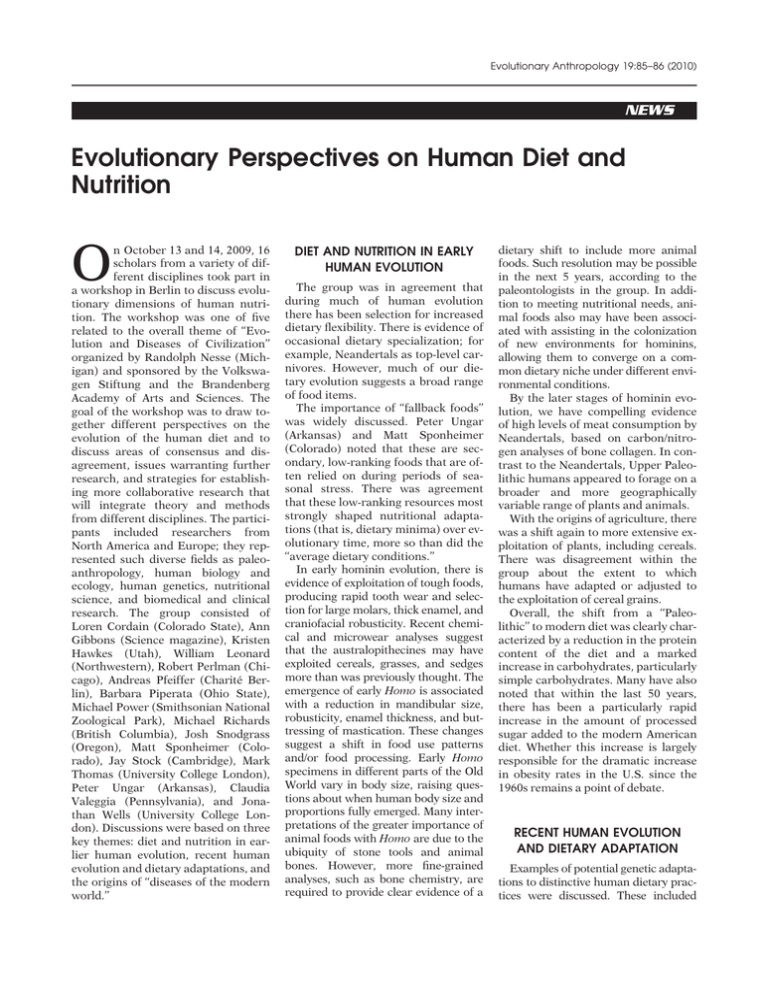
Evolutionary Anthropology 19:85–86 (2010) NEWS Evolutionary Perspectives on Human Diet and Nutrition O n October 13 and 14, 2009, 16 scholars from a variety of different disciplines took part in a workshop in Berlin to discuss evolutionary dimensions of human nutrition. The workshop was one of five related to the overall theme of ‘‘Evolution and Diseases of Civilization’’ organized by Randolph Nesse (Michigan) and sponsored by the Volkswagen Stiftung and the Brandenberg Academy of Arts and Sciences. The goal of the workshop was to draw together different perspectives on the evolution of the human diet and to discuss areas of consensus and disagreement, issues warranting further research, and strategies for establishing more collaborative research that will integrate theory and methods from different disciplines. The participants included researchers from North America and Europe; they represented such diverse fields as paleoanthropology, human biology and ecology, human genetics, nutritional science, and biomedical and clinical research. The group consisted of Loren Cordain (Colorado State), Ann Gibbons (Science magazine), Kristen Hawkes (Utah), William Leonard (Northwestern), Robert Perlman (Chicago), Andreas Pfeiffer (Charité Berlin), Barbara Piperata (Ohio State), Michael Power (Smithsonian National Zoological Park), Michael Richards (British Columbia), Josh Snodgrass (Oregon), Matt Sponheimer (Colorado), Jay Stock (Cambridge), Mark Thomas (University College London), Peter Ungar (Arkansas), Claudia Valeggia (Pennsylvania), and Jonathan Wells (University College London). Discussions were based on three key themes: diet and nutrition in earlier human evolution, recent human evolution and dietary adaptations, and the origins of ‘‘diseases of the modern world.’’ DIET AND NUTRITION IN EARLY HUMAN EVOLUTION The group was in agreement that during much of human evolution there has been selection for increased dietary flexibility. There is evidence of occasional dietary specialization; for example, Neandertals as top-level carnivores. However, much of our dietary evolution suggests a broad range of food items. The importance of ‘‘fallback foods’’ was widely discussed. Peter Ungar (Arkansas) and Matt Sponheimer (Colorado) noted that these are secondary, low-ranking foods that are often relied on during periods of seasonal stress. There was agreement that these low-ranking resources most strongly shaped nutritional adaptations (that is, dietary minima) over evolutionary time, more so than did the ‘‘average dietary conditions.’’ In early hominin evolution, there is evidence of exploitation of tough foods, producing rapid tooth wear and selection for large molars, thick enamel, and craniofacial robusticity. Recent chemical and microwear analyses suggest that the australopithecines may have exploited cereals, grasses, and sedges more than was previously thought. The emergence of early Homo is associated with a reduction in mandibular size, robusticity, enamel thickness, and buttressing of mastication. These changes suggest a shift in food use patterns and/or food processing. Early Homo specimens in different parts of the Old World vary in body size, raising questions about when human body size and proportions fully emerged. Many interpretations of the greater importance of animal foods with Homo are due to the ubiquity of stone tools and animal bones. However, more fine-grained analyses, such as bone chemistry, are required to provide clear evidence of a dietary shift to include more animal foods. Such resolution may be possible in the next 5 years, according to the paleontologists in the group. In addition to meeting nutritional needs, animal foods also may have been associated with assisting in the colonization of new environments for hominins, allowing them to converge on a common dietary niche under different environmental conditions. By the later stages of hominin evolution, we have compelling evidence of high levels of meat consumption by Neandertals, based on carbon/nitrogen analyses of bone collagen. In contrast to the Neandertals, Upper Paleolithic humans appeared to forage on a broader and more geographically variable range of plants and animals. With the origins of agriculture, there was a shift again to more extensive exploitation of plants, including cereals. There was disagreement within the group about the extent to which humans have adapted or adjusted to the exploitation of cereal grains. Overall, the shift from a ‘‘Paleolithic’’ to modern diet was clearly characterized by a reduction in the protein content of the diet and a marked increase in carbohydrates, particularly simple carbohydrates. Many have also noted that within the last 50 years, there has been a particularly rapid increase in the amount of processed sugar added to the modern American diet. Whether this increase is largely responsible for the dramatic increase in obesity rates in the U.S. since the 1960s remains a point of debate. RECENT HUMAN EVOLUTION AND DIETARY ADAPTATION Examples of potential genetic adaptations to distinctive human dietary practices were discussed. These included NEWS 86 Leonard, Stock and Valeggia lactase persistence, amylase and starch digestion, alcohol metabolism, and skin color and vitamin D metabolism. Of the examples discussed, the ability, after the weaning age, to digest lactose was seen as the strongest case of natural selection for a particular dietary adaptation. However, there were differences of opinion and broad discussion on the nature of selection for lactase persistence. Mark Thomas (University College London) argued that selection is episodic, acting most strongly during lean times. He proposed that consumption of milk and dairy products acts as ‘‘buffering’’ for the bad times during farming lows. When the going got tough, lactase persistence allowed farming people to drink milk without having diarrhea. Thomas’ work shows that lactase persistence likely originated in central Europe (the Balkans) but, because of demographic processes associated with the spread of farming and dairy subsistence, its distribution was shifted north and west to, for example, Scandinavia and Ireland. This is consistent with the archeological evidence in the European Neolithic. In addition to the cultural hypothesis for the selection of lactase persistence, Loren Cordain (Colorado State) presented a novel hypothesis on the possibility that lactase has an indirect effect on resistance to malaria. The malaria plasmodium needs to use the host’s para-aminobenzoic acid (PABA) to survive. Milk is PABA-deficient; therefore, a diet rich in dairy products may favor resistance to malaria. Lactase is preserved as a way to promote milk consumption and malaria resistance into adulthood. ORIGINS OF ‘‘DISEASES OF THE MODERN WORLD’’ The role of dietary factors in the development of ‘‘diseases of the modern world’’ was discussed at length. There was wide agreement that the process of lifestyle and dietary ‘‘modernization’’ does not produce the same health effects in all human populations. Rather, there are remarkable disparities across different ethnic groups. Some populations, such as the Pima, respond with increases in the incidence of diabetes and metabolic syndrome, whereas others, such as native Siberians, show a low incidence of diabetes with Westernization of diets, but high rates of hypertension. Variation in obesity risks was discussed at length. There is accumulating evidence of population differences in both rates of fat oxidation and fat deposition. Andreas Pfeiffer (Charité Berlin) noted that increased health risks are associated with large abdominal fat deposits. In addition, Mike Power (Smithsonian National Zoological Park) pointed out that adipose tissue, in addition to storing energy, contains enzymes that transform steroid hormones, which in turn affect reproduction. This recent recognition of fat as an important endocrine and immune regulator has led us to see adipose tissue as playing a more dynamic role in shaping physiology and in the origin of nutritionrelated diseases. Jonathan Wells (University College London) pointed out that a certain amount of abdominal fat is essential for immune function. Fat has macrophages and may be important to fight disease in high-disease-load populations. These new insights into the multiple roles of adipose tissue raise important new questions about how factors such as sex differences, reproductive strategies, disease loads, and ethnicity shape variation in the storage and activity of fat. There was agreement on the importance of shifting energy balance as being the central driver behind the rise of obesity in the industrialized societies. Bill Leonard (Northwestern) noted that data from the U.S. show only modest increases in energy intakes over the last 40 years, suggesting that dietary change alone cannot explain the dramatic increase in obesity rates. This underscores the importance of changes in activity patterns. Yet, as Josh Snodgrass (Oregon) pointed out, we still have relatively little good comparative and longitudinal data on changes in activity patterns and energy expenditure, owing to the difficulty in measuring these parameters The importance of differences in dietary quality was also seen as having a central role in the obesity epidemic. Jonathan Wells noted that the obesity epidemic in the U.S. coincides with the American Heart Association first promoting a low-fat diet, resulting in people eating more simple carbohydrates. In addition, the processing of sugars, particularly sucrose, in food manufacturing changed the glycemic indices and the energy availability of manufactured foods. The group was in agreement that understanding both the nature of variation in risks of obesity and the links between nutrition and chronic diseases are important tasks for researchers in human nutritional evolution. What are the determinants of differences in response to diet changes? What are the contributions of genetic, social, and epigenetic factors to variation in health outcomes in response to dietary change? These are key unanswered questions. William R. Leonard Northwestern University E-mail: w-leonard1@northwestern.edu Jay T. Stock Cambridge University E-mail: j.stock@human-evol.cam.ac.uk Claudia R. Valeggia University of Pennsylvania E-mail: valeggia@sas.upenn.edu C 2010 Wiley-Liss, Inc. V Published online in Wiley InterScience (www.interscience.wiley.com). DOI 10.1002/evan.20250


